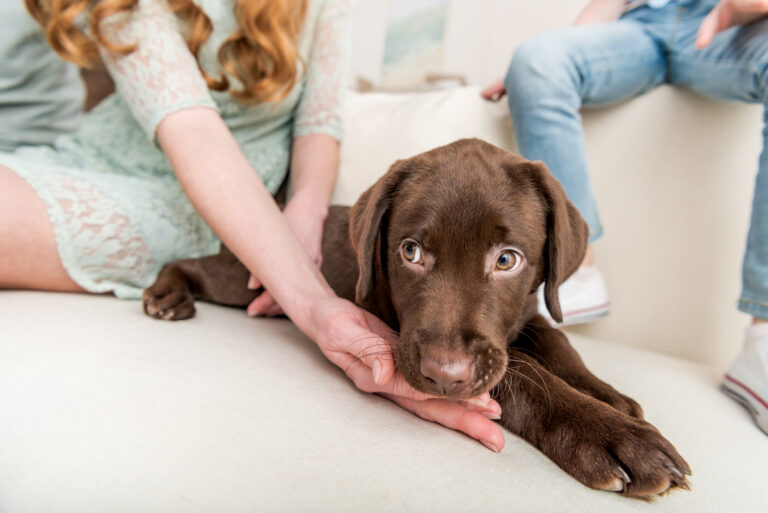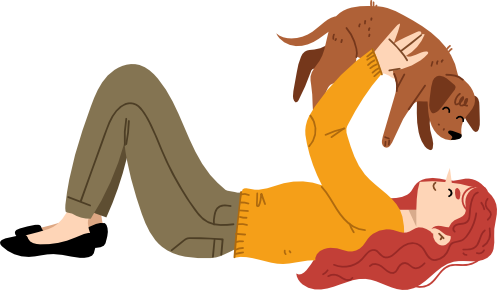I leashed up my puppy Niffler as he jumped from my Prius. The sun was warm, the scent of Ponderosa pines heavy in the spring air. We headed down the trail, relishing in that first warm day of the year.
But within a few minutes, it all went so wrong. Another crew of hikers rounded the corner and Niffler reacted immediately – his hackles shot up, he leapt behind me, and started to bark ferociously. It was the first time I’d heard him bark like a big dog, and he sounded scary.
When he was five months old, I realized that my puppy had some Stranger Danger concerns. This isn’t entirely unexpected – he was born on a farm in Idaho, raised on 5 acres in rural Montana during a global Pandemic. Did I mention I brought him home in December?
So he simply hasn’t seen all that many people yet, despite our visits to Cabela’s and Ace Hardware and puppy kindergarten. People on trails were a startling and upsetting novelty.
That doesn’t mean I’m going to ignore the problem, though! I’m a dog trainer and I really like my dogs to feel comfortable in a wide variety of situations. Barley, my adult dog, is my constant companion at all dog-friendly venues, and I’d like Niffler to follow in his pawprints.
We also recorded a podcast episode on Stranger Danger, which you can find here.
My approach for working with a puppy on stranger danger is a few simple steps:
- Do not make it worse. Avoid forcing your puppy into a situation that makes them nervous – this usually backfires in the long run even if it appears to be working at the time. Correcting your puppy for being startled or scared (even if they’re growling or otherwise behaving aggressively) can also backfire.
- Your job from here on out is to reduce your puppy’s exposure to strangers in uncontrolled scenarios so that they can learn to feel safe with strangers.
- For Niffler and me, this meant ensuring that we brought Barley on hikes (Niffler is more confident with Barley around) and chose dog-friendly areas (Niffler is more comfortable with other dogs) that were wide open (Niffler is more comfortable when he can see people coming from a ways away versus popping out of the brush).
- Strategize encounters. Now when I see people coming down the trail, I call out to them in a friendly way, “Hi, how’s it going?” They reply, and then I say, “My puppy might bark at you, he’s a bit nervous of strangers. I’m just going to step over here to let you pass and feed him some treats.” Then I do so! This gentle but firm instruction has worked really well for me so far. Niffler seems more relaxed when I clearly interact with the other people in a friendly way, too.
- Over time, we’re closing the distance that we move so that Niffler is getting closer and closer to passing people “normally” rather than giving them a wide berth. But at first, I had to move 10 feet off the trail to ensure he felt comfortable enough to eat! If he’s barking, growling, shaking, or even just not eating, we were too close to the strangers.
- We give an extra-wide berth to men and children, who seem to scare Niffler a bit more. He is much more comfortable with groups with dogs, so we will interact more closely with them.
- I’m careful not to force Niffler to interact. Ideally, he’s off-leash on the hiking trails and can dictate his own comfort level with interactions. Even if he’s leashed, I make sure to let him retreat or move away however he needs.
- Countercondition. You’ll notice that above I mentioned giving Niffler plenty of treats when we see people pass. I play a version of Leslie McDevitt’s “Look at That” game, or the “Engage Disengage” game. Whatever you call it, the basic idea is to let your puppy look at the stranger from a distance, then feed them. At first, you may have to praise your puppy after a few seconds so that they stop staring; then give them a treat. After a few repetitions of this gentle reminder to look at you, your puppy will probably start to look at you and the stranger in turn. If they don’t, or they can’t eat, you’re too close! Move away and try again.
- Over time, you can decrease the space between your puppy and the strangers. You will likely notice that progress is not linear and that some situations will feel harder than others. That’s normal! Running or screaming kids, or people who stop and stare at your dog, are often scarier than a young woman walking away from you.
Remember to be patient and get help if needed! Be sure to check out the episode we did on this topic for Pandemic Puppy as well.

